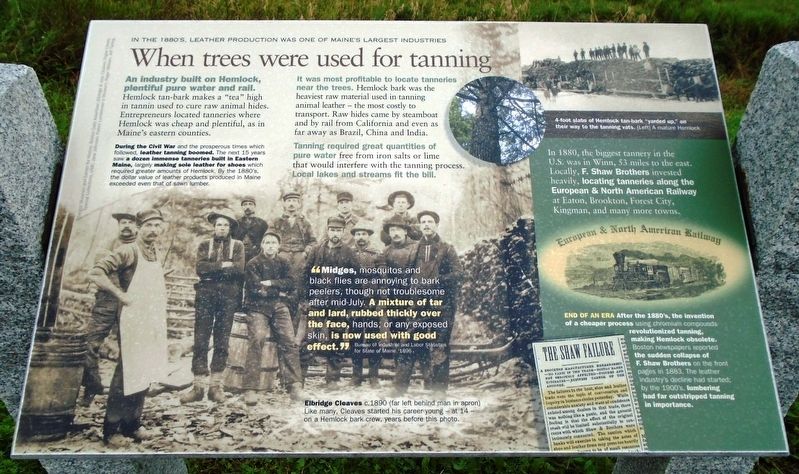When trees were used for tanning
In the 1880's, leather production was one of Maine's largest industries
An industry built on Hemlock, plentiful pure water and rail. Hemlock tan-bark makes a "tea" high in tannin used to cure raw animal hides. Entrepreneurs located tanneries where Hemlock was cheap and plentiful, as in Maine's eastern counties.
It was most profitable to locate tanneries near the trees. Hemlock bark was the heaviest raw material used in tanning animal leather - the most costly to transport. Raw hides came by steamboat and by rail from California and even as far away as Brazil, China and India.
Tanning required great quantities of pure water free from iron salts or lime that would interfere with the tanning process. Local lakes and streams fit the bill.
During the Civil War and the prosperous times which followed, leather tanning boomed. The next 15 years saw a dozen immense tanneries built in Eastern Maine, largely making sole leather for shoes which required greater amounts of Hemlock. By the 1880's, the dollar value of leather products produced in Maine exceeded even that of sawn lumber.
"Midges, mosquitos and black flies are annoying to bark peelers, though not troublesome after mid-July. A mixture of tar and lard, rubbed thickly over the face,
hands, or any exposed skin, is now used with good effect."Bureau of Industrial and Labor Statistics for State of Maine, 1896
[Bottom left photo caption reads]
Elbridge Cleaves c.1890 (far left behind man in apron) Like many, Cleaves started his career young - at 14 - on a Hemlock bark crew, years before this photo.
[Top right photo captions read]
4-foot slabs of Hemlock tan-bark "yarded up," on their way to the tanning vats. [Left] A mature Hemlock
In 1880, the biggest tannery in the U.S. was in Winn, 53 miles to the east. Locally, F. Shaw Brothers invested heavily, locating tanneries along the European & North American Railway at Eaton, Brookton, Forest City, Kingman, and many more towns.
End of an Era
After the 1880's, the invention of a cheaper process using chromium compounds revolutionized tanning, making Hemlock obsolete. Boston newspapers reported the sudden collapse of F. Shaw Brothers on the front pages in 1883. The leather industry's decline had started; by the 1900's, lumbering had far outstripped tanning in importance.
Topics. This historical marker is listed in these topic lists: Environment • Industry & Commerce • Settlements & Settlers. A significant historical year for this entry is 1896.
Location. 45° 44.241′
Other nearby markers. At least 8 other markers are within 6 miles of this marker, measured as the crow flies. A rich fishing tradition continues year-round (a few steps from this marker); Chiputneticook Chain of Lakes (within shouting distance of this marker); Town of Weston Honor Roll (approx. ¼ mile away); Rivers & Streams: Ancient Highways of the Wabanaki (approx. 3.1 miles away); The "sleeping giant" view of Mount Katahdin (approx. 3.1 miles away); Weston & Danforth's architecture (approx. 3.1 miles away); Welcome to Million Dollar View Scenic Byway (approx. 3.1 miles away); Orient Veterans Memorial (approx. 5.6 miles away). Touch for a list and map of all markers in Weston.
Also see . . .
1. History of Tanning in the State of Maine (Riley, Thesis 1935). (Submitted on October 22, 2018, by William Fischer, Jr. of Scranton, Pennsylvania.)
2. Million Dollar View Scenic Byway. (Submitted on October 22, 2018, by William Fischer, Jr. of Scranton, Pennsylvania.)
Credits. This page was last revised on October 22, 2018. It was originally submitted on October 22, 2018, by William Fischer, Jr. of Scranton, Pennsylvania. This page has been viewed 299 times since then and 37 times this year. Photos: 1, 2. submitted on October 22, 2018, by William Fischer, Jr. of Scranton, Pennsylvania.

